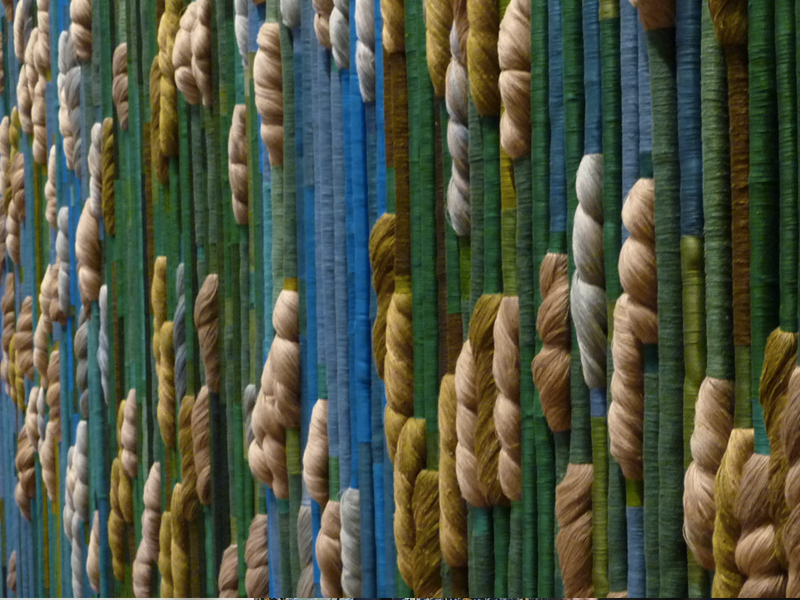This week we continue our Women’s History Month series with a closer look at the incredible work of fiber artist, Sheila Hicks. While Hicks is not strictly a textile designer, she helped pave the way for a more open-minded investigation of the arbitrary divide between traditional crafts and those deemed professional arts. As such, we honor Hicks for her role in bringing a greater understanding and appreciation to the genre of fiber and fabric as a whole.

Dutch National Archief, 1974 | Source
Born in Nebraska in 1934, Sheila Hicks was exposed at an early age to both the functional and aesthetic qualities of fiber work. The female members of her family ensured that she was grounded in all manner of knitting and sewing techniques. For this reason, Hicks has famously described herself as being “thread conscious.”

Lianes de Beauvais at the Centre Pompidou, 2013 | Source
It is interesting to note that Hicks entered the sphere of formal education with a focus on painting. During her time at Yale, her professor, renowned artist Josef Albers, instructed her in the principles behind the modernist Bauhaus style, particularly the under-acknowledged merit of the so-called “applied” arts. Meanwhile, George Kubler’s course on Latin America nurtured Hicks’ growing fascination with indigenous textiles. These concurrent interests naturally led Hicks to Albers’ wife, Anni, a textile specialist who would facilitate Hicks’ introduction to the world of weaving. In 1957, thanks to a Fulbright scholarship, Hicks traveled to South America to explore a vast variety of artisanal fiber techniques.

Installation at the Toronto Textile Museum, 2016 | Source
Upon returning to Yale to complete her graduate studies, Hicks began to rebuff against the artificial parameters separating painting and sculpture from what she could create with fibers and woven materials. This innovative stance would become a strong undercurrent throughout her professional career. In Hicks’ own words:
What is tapestry and what is not? And what should we squelch before it goes too far? I was moving around between different techniques — of stitching, wrapping, braiding, weaving, twining — exploring all these different thread languages. And tapestry was one of them, but traditionally the prestigious one. So my work was equated with a kind of graffiti.
This experimental attitude is exemplified in Hicks’ extensive collection of “minimes”. These small-scale works, woven upon a handloom, represent a testing ground for color, texture, and style. As such, they often incorporate found materials such as feathers or shells while also playing with the warp and weft to create unexpected unwoven effects. In many respects, the minimes illustrate how Hicks absorbs and reinterprets the diverse influences and environments around her.

Silk Rainforest at the Smithsonian American Art Museum, 2011 | Source
At the same time, Hicks is also well known for her large, bespoke installations. Among these include: bunched “ponytail” braids, intertwined multicolor spools, wrapped spherical bundles as well as embroidered intricate shapes. Many of these are intended to be experienced not only visually, but also tactilely and spatially. Furthermore, Hicks has even imaginatively reworked some of her installations to fit different spaces.

Installation for the Ford Foundation Building, 2015 | Source
Hicks’ career embodies the extremes of artistic venture. She has produced work for both private commercial commissions as well as prestigious museums of art and design. She has worked in Mexico as well as Paris. Some of her works are attached to walls while others are free standing structures. Hicks has created intense monochromatic studies and vibrant polychromatic wonders. She draws from historical traditions in addition to modernist precepts. Her pieces have encompassed entire building structures as well as minimalist patches of wall. And finally, the fibers in her works have been manipulated in nearly every technique imaginable.
Over the past 50 years, Sheila Hicks has proved that fiber art has an infinite capacity for innovation. Here at WeaveUp, we love how digital printing technology offers you the opportunity to transform your own artistic vision into material reality.



Leave A Comment